Analysis of JM Turner painting Buttermere Lake with a part of Cromackwater
Analysis of JM Turner's Painting "Buttermere Lake with a Part of Cromackwater"
Joseph Mallard Turner's painting, "Buttermere Lake, with a Part of Cromackwater, Cumberland, a shower," exhibited at the UK Royal Academy in 1798, is a captivating and atmospheric masterpiece. This dark and stormy scene evokes a sense of awe, wonder, and even fear of nature, as Turner skillfully captures the Sublime. One intriguing element of the painting is the presence of a white bow that bridges the scene, leaving viewers puzzled about its nature and significance.
The exact nature of the white bow in Turner's painting has been a subject of speculation. Some have suggested that it could be a white fogbow or a ghostly moonbow in a night scene. However, upon closer examination, it becomes clear that the painting depicts a daytime scene, making it unlikely to be a fogbow or moonbow. So, if it is a rainbow, why is it white? Did Turner observe the bow directly or did he add it in his London studio? These questions add to the mystery surrounding this captivating artwork.
Turner based his painting on a sketch he made during an eight-week tour of the North of England the previous summer. While the sketch depicts a lighter and less dramatic scene, Turner noted "black" on the nearby Crummock Water, indicating his intention to portray a moody atmosphere. However, the exact moment when Turner added the colors to his painting remains uncertain. Did he do it on the same evening at his inn or later back in his London studio? This ambiguity adds an element of intrigue to the artistic process behind the creation of this masterpiece.
The misty white cone shape at the center of the painting serves as the only hint of what might become a bow. When examining computer simulations of fogbows, we can observe how they progressively broaden from a narrow rainbow to fogbows made by smaller and smaller fog droplets. However, the bow in Turner's painting is too narrow to be a fogbow. Its height and almost semicircular shape suggest that the sun (or moon) was low in the sky, only a few degrees above the horizon. This indicates that the painting depicts a near sunset scene.
By analyzing the landscape colors, lighting, and the position of the bow, we can infer that the painting looks to the southeast. Since all bows are opposite their light source, the sun or moon must be low in the northwest. The orange light illuminating some fields and the village of Buttermere indicates a near sunset scene. The clouds, with their characteristic Turner murky yellow-orange highlights, further confirm this assumption. Additionally, the play of light and shade on the hills aligns with a near sunset setting. Therefore, we can conclude that the painting depicts a rainbow extending in front of the distant hills, indicating a nearby shower, as stated in the painting's title.
While some may argue that the white bow could be a fogbow or moonbow due to its lack of distinct colors, Turner's portrayal of rainbows predominantly without color is not a flaw in his artistic ability. On the contrary, it is a deliberate choice that better conveys a rainbow's luminosity, transparency, and ethereality. Many attempts to paint rainbows result in garish or unreal depictions. Turner's white bows, with their faint red and blue edges, successfully capture the spirit and essence of rainbows without overwhelming the viewer with excessive colors.
However, it is important to note that Turner took some artistic liberties with the placement of the bow in his painting. Based on his location and the angle of the sun during a near sunset summer solstice, the actual position of the bow would be even further left than he depicted it. This compositional decision allowed Turner to create a visually pleasing and balanced composition, even if it deviated from scientific accuracy.
Interestingly, Turner also included a bow reflection, known as a "reflected bow," to the left of the lone boatman in the painting. However, similar to the placement of the main bow, this reflection is also inaccurately positioned. Turner aligned the reflection with the circle of the rainbow, which would only occur at exact sunset. This further demonstrates his artistic license and willingness to prioritize visual harmony over scientific accuracy.
In conclusion, Turner's painting "Buttermere Lake, with a Part of Cromackwater, Cumberland, a shower" is a captivating depiction of nature's power and beauty. The presence of the white bow adds an element of intrigue and mystery to the artwork. Through careful analysis of the landscape, lighting, and artistic choices, we can deduce that the bow is indeed a rainbow representing a nearby shower during a near sunset scene. Turner's decision to portray rainbows predominantly without color is a testament to his artistic skill in capturing the luminosity and ethereal qualities of these natural phenomena. Despite some deviations from scientific accuracy in the placement of the bow and its reflection, the painting remains a masterpiece that continues to captivate viewers to this day.

The 23 year old Joseph Mallard Turner exhibited "Buttermere Lake, with a Part of Cromackwater, Cumberland, a shower" at the UK Royal Academy in 1798.
It is a dramatic, dark and stormy scene. Light of some sort spills fitfully on the village of Buttermere in middle distance. while the foreground Crummock water and crags are in inky shadow.
Turner is conjuring the Sublime - evoking awe, wonder and even fear of Nature.
A white bow bridges the scene. What exactly is it? A white fogbow? A night scene with a ghostly moon bow? Or, if it is daytime and it is a rainbow, why is it white? Did Turner observe the bow directly or did he add it in his London studio? If the latter, did he get it right?
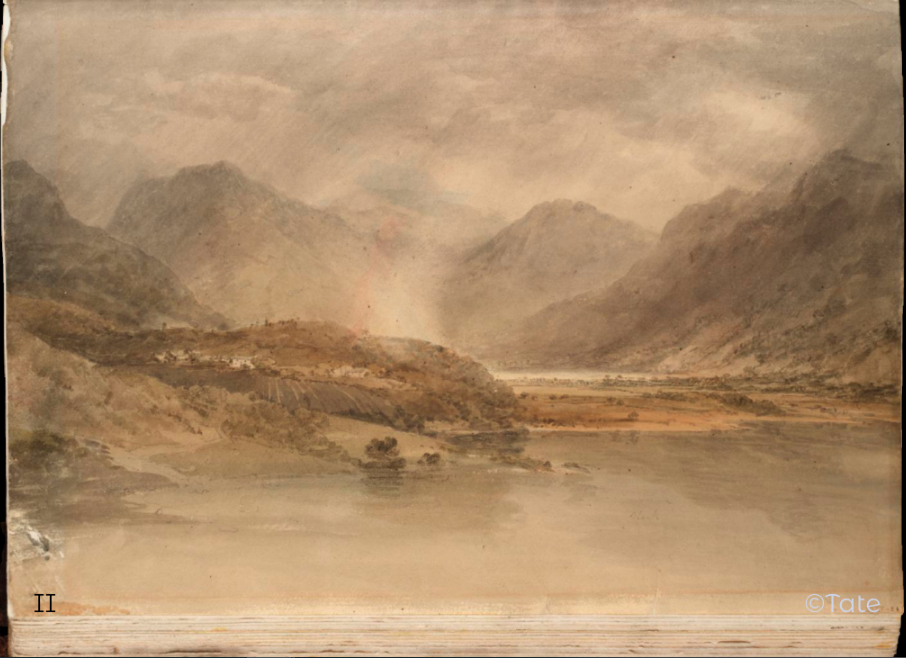
The painting is based on a sketch made the previous summer while Turner was on an eight week long and several hundred-mile tour of the North of England.
Although the scene is lighter and less dramatic, Turner pencilled a colour note "black" on the nearby Crummock Water indicating that he already knew the mood to portray. Where and when he added the colours is uncertain. The same
evening at his inn? Later back at his London studio?
The misty white cone shape at centre is the only hint of what might become a bow. An enhancement of this area is below.
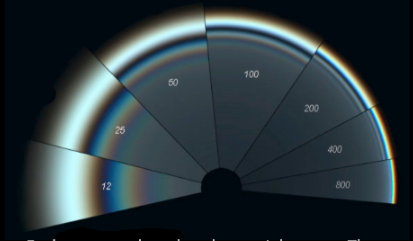
Fogbows are broader than rainbows. These computer simulations show the progressive broadening from a narrow rainbow at far right to fogbows made by smaller and smaller fog droplets. Numbers are the drop diameter in microns.
The bow's shape, the landscape colour and lighting The bow's height and almost semicircular shape tell us the sun (or moon) was low in the sky. Only a few degrees high as estimated from the bow's height.
The picture looks to the south-east and, since all bows are opposite their light source, the sun or moon must be low in the NW. Some fields and village of Buttermere are in fairly sharp orange light. The clouds have some characteristic Turner murky yellow-orange highlights with more hints of ange/red on something like Prussian blue or ultramarine. This all indicates a near sunset scene. The light and shade on the hills also confirms near sunset. Not a nocturnal scene with a moonbow.
Fogbow or rainbow? Neither the painting nor the sketch have fog or mist. Distant hills are sharp and clear. The sky is stormy. Not fogbow conditions. The bow is also too narrow to be a fogbow. We are left with a rainbow. It extends in front of the distant hills indicating a nearby shower just as Turner says in the title. Effective as the white bow appears, where are the true
colours?
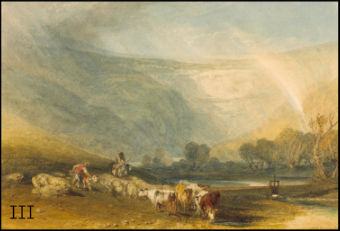
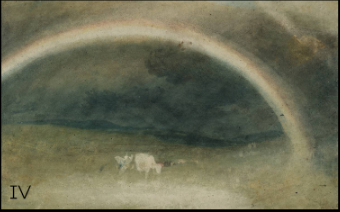
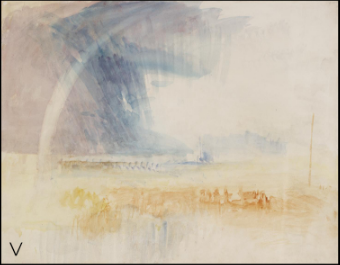
Three of Turner's bows. They are all nearly white with faint red and blue edges. The central
one might just be a fogbow except that a secondary fogbow is rarely visible let alone one
so narrow.
Click images for their museum illustrations. Titles and credits are at foot of page.
Why white?
Turner painted many rainbows, mostly in watercolour.
His Buttermere bow is not alone in lacking colour. It is not entirely white. There are occasional hints of red and blue, especially at its top. Many of Turner's almost white bows have a faint red stripe on their outer edge and blue on their inner.
Rainbows are devilishly difficult things to portray in paintings. To merge the multiple hues well in their correct geometric positions is hard A further challenge is reproducing the
bow's delicacy and transparency. There are very few natural bows so intense that you feel you could slide down them. Or safely walk across Bifrost from Midgard to Valhalla. Those bows
are the exceptions. Most attempts to paint rainbows result in something that is just unreal and unconvincing, or garish.
Did Constable fully succeed with Salisbury Cathedral? FE Church, the superb painter of the American Sublime, arguably failed with his Rainy season in the Tropics. Church himself put
a white bow into his 1856 Niagara painting as did Bierstadt.
That Turner chose to portray rainbows largely without colour is no criticism of his ability. On the contrary, with his white bows he got it right. His almost symbolic renditions avoid garishness and solidity. He conveys successfully their spirit, luminosity and ethereality.
What more could we want?
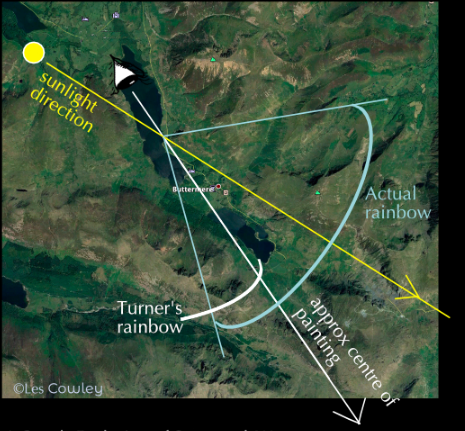
A Google Earth view of Crummock Water at top with Buttermere below. North is upwards. A blue curve marks a rainbow as seen from Turner's approximate position near sunset at the summer solstice. The rainbow curves upwards to the left of the painting's centreline. The actual bow at all other times and dates is even further left. Turner's bow is impossible.
Is the bow accurately placed?
Turner's 1797 sketch shows little or no sign of a bow. There might be a hint in the white patch at centre where the subsequent oil painting's bow nears the ground. The painting's bow was added in the London studio without (known) references to on site observations.
A sunset rainbow at his location has its extreme position at the summer solstice. The sun then sets at its furthest north and the bow's centre at its furthest south. This is to left in the painting. Bows at other dates are even further left.
The map at left show the midsummer bow together with Turner's. A bow as he placed it is impossible except near a dawn - but the hillside shadows are only consistent with sunset.
Compositionally he used his artistic licence wisely, a rainbow in the scientifically accurate position just would not have worked.
The reflected bow
There is a bow reflection - technically a 'reflected bow' - to the left of the lone boatman. Not to add insult, this one is also incorrectly placed. Turner has put his reflection more or less on a continuation of his rainbow's circle. That would only happen at exact sunset.
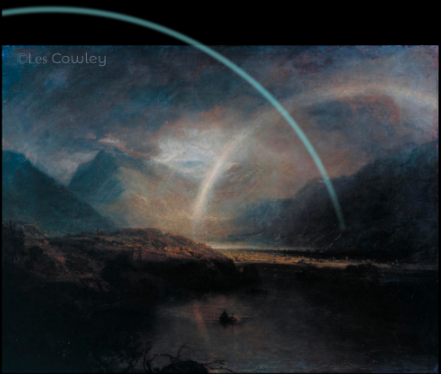
The approximate position of a near sunset summer solstice rainbow superimposed on the painting. ALL afternoon/evening bows at other times and dates would appear to the left of the solstice bow.
Toying with rainbows?
Turner's on-site 1797 sketch (at top) perhaps shows evidence of experimentation with a rainbow's inclusion. 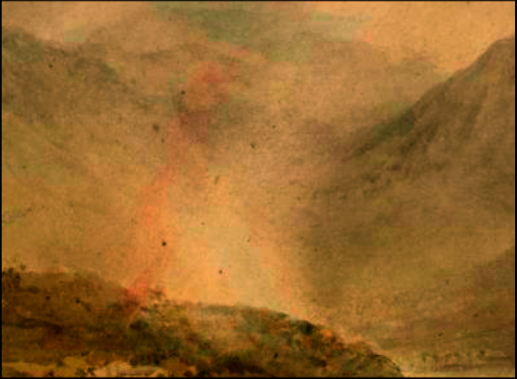
The near centre cone of misty white is here enhanced to emphasise the faint red brush marks already evident on the original reproduction.
Several red brush strokes arc up to the right at a similar angle to his 1798 'incorrect' rainbow. Two fainter red arcs and a central slightly blue one curve up leftwards at the angle an actual bow would take near sunset at a date not too far from the solstice.
Was Turner using the sketch to play with possible rainbow positions? Did he actually see a trace of rainbow out there on the banks of Crummock Water?
Summary
Turner's white bow could - on its own - be interpreted as a moonbow, fogbow or rainbow. A combination of factors show it to be a rainbow with the sun low in the western sky.
The white rather than coloured bow is a common Turner portrayal and better conveys a rainbow's luminosity, transparency and ethereality. Other, later, painters of the Sublime did the same.
Turner took considerable liberties for compositional purposes with the bow placement. His bow's position is impossible. Any afternoon or evening bows visible at his sketching location would be on the painting's left.
The placement of the bow's reflection in the nearby water is erroneous.
There is some evidence that he experimented with bow positions on his 1797 sketch.
All this is not to distract from a masterpiece.
Attributions & Acknowledgements
My thanks to Gavin Pretor-Pinney of the Cloud Appreciation Society for the discussions we've had on this painting. Thanks to The Tate Gallery and the National Gallery, London for
permission to reproduce images.
1- Buttermere Lake, with a Part of Cromackwater, Tate Gallery, London
JMW Turner, Buttermere Lake, with a Part of Cromackwater, Cumberland, a shower, 1798 Tate N00460, digital image © Tate released under Creative Commons CC-BY-NC-ND (3.0 Unported)
II - Crummock Water, Looking towards Buttermere - From 1797 sketchbook, Tate
JMW Turner, Crummock Water, Looking towards Buttermere, 1797 Tate D01086, digital image © Tate released under Creative Commons CC-BY-NC-ND (3.0 Unported)
III - Malham Cove with Cattle Grazing, The British Museum JMW Turner, Malham Cove with Cattle Grazing, 1797 British Museum 1910,0212.277, digital image ©The Trustees of the British Museum.
IV-A Rainbow, with Cattle, Tate
JMW Turner, A Rainbow, with Cattle, c1815 Tate D17197, digital image © Tate released under Creative Commons CC-BY-NC-ND (3.0 Unported)
V - Rainbow and Coastal Terrain, Tate
JMW Turner, Rainbow and Coastal Terrain, c18140-5 Tate D36302, digital image © Tate released under Creative Commons CC-BY-NC-ND (3.0 Unported)
Note: this article has been automatically converted from the old site and may not appear as intended. You can find the original article here.
Reference Atmospheric Optics
If you use any of the definitions, information, or data presented on Atmospheric Optics, please copy the link or reference below to properly credit us as the reference source. Thank you!
-
<a href="https://atoptics.co.uk/blog/analysis-of-jm-turner-painting-buttermere-lake-with-a-part-of-cromackwater/">Analysis of JM Turner painting Buttermere Lake with a part of Cromackwater</a>
-
"Analysis of JM Turner painting Buttermere Lake with a part of Cromackwater". Atmospheric Optics. Accessed on November 26, 2024. https://atoptics.co.uk/blog/analysis-of-jm-turner-painting-buttermere-lake-with-a-part-of-cromackwater/.
-
"Analysis of JM Turner painting Buttermere Lake with a part of Cromackwater". Atmospheric Optics, https://atoptics.co.uk/blog/analysis-of-jm-turner-painting-buttermere-lake-with-a-part-of-cromackwater/. Accessed 26 November, 2024
-
Analysis of JM Turner painting Buttermere Lake with a part of Cromackwater. Atmospheric Optics. Retrieved from https://atoptics.co.uk/blog/analysis-of-jm-turner-painting-buttermere-lake-with-a-part-of-cromackwater/.